How the Easter bunny and colorful eggs originated from ancient spring traditions

Why some ancient pagan traditions are still part of Easter today
Easter is a time when Christians celebrate the resurrection of Christ, but a few aspects of the holiday were adopted from religions outside of Christianity. (Video: FOX Weather)
Easter brings together an unlikely cadre of traditions: church, bunnies and eggs.
What may seem like an odd trio, however, is actually tied together by the universal themes of spring and life renewed.
While Easter is a time when Christians celebrate the resurrection of Christ, a few aspects of the holiday were adopted from ancient pagan rituals celebrated the annual resurrection of life during the spring.
Traditions with Christian and pagan roots

A parishioner and church usher carry a cross from the beach after the 21st annual Easter sunrise celebration service on March 27, 2016 in Boulder, Colorado. (Helen H. Richardson / The Denver Post / Getty Images)
"For Christians, Easter has always been about celebrating the central miracle of Jesus’s death and resurrection," said Andrew Hann, the head of the Historians’ Team at English Heritage, the heritage organization covering England within the United Kingdom.
Hann noted that while Easter has been an important date in the Christian calendar since the earliest days of Christianity, the origins of certain aspects of the holiday are quite complex.
"What we now know is that Easter has a lot of pagan origins," he said. "So, it comes from a lot of traditions that are much earlier than Christianity itself."
The through line among these traditions is resurrection. While Christianity focuses on the resurrection of Christ, believers of pagan religions focused on the natural world and celebrated when it "resurrected" in the spring.

The resurrection of life in the spring is a common theme among Christian and pagan beliefs. Here, parishioners at the 12th Baptist Church in Boston prepare flowers, a symbol of spring, for Easter Sunday service. (Mark Garfinkel / MediaNews Group / Bo
The pre-Christian, pagan period contains many stories about resurrection and springtime, according to Hann.
For example, 2,000 years before Christ, the Sumerians in Mesopotamia had a tradition around the goddess Inanna, who descended into the underworld during winter and was brought back to life once winter ended.
THE PAGAN AND CHRISTIAN ORIGINS OF HALLOWEEN
"Rebirth is very central to traditions going right back to the very early days of civilization," Hann said. "The story is going through all these different religions that have this idea of rebirth in the spring and which is very, very closely linked to the Christian tradition."
Here are a few examples of how Christian and pagan elements came together to form the Easter holiday we know today.
The goddess behind the name
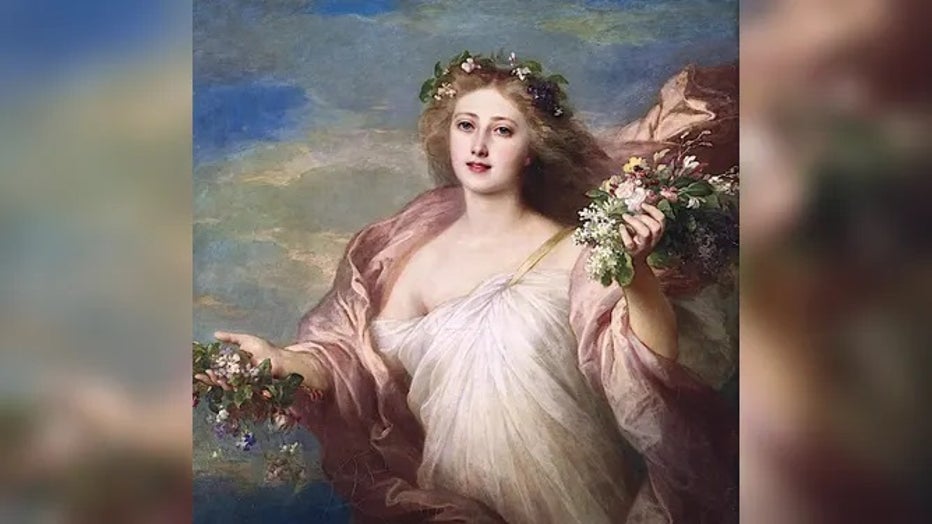
The spring goddess Eostre, as depicted by Franz Xaver Winterhalter in his painting titled "Spring".
One of the pagan influences of the holiday involves its name.
While some cultures refer to the holiday through variations of its Latin name "Pascha," many others refer to it by a name that originated in northern European traditions – Easter.
"Easter" is linked to the pagan springtime goddess Eostre, according to Hann. Celebrated during the spring equinox, Eostre was first documented in the eighth century and is associated with some Easter traditions that have lasted to this day.
The traditional Easter dish of hot cross buns, for example, may be linked to the goddess.

Traditional Easter hot cross buns may have ties to the goddess Eostre. (Natasha Breen / REDA & CO / Universal Images Group / Getty Images)
While there may be a Christian association with the buns, due to the cross symbolizing the crucifixion of Christ, Hann noted that the buns are linked to the goddess Eostre, who had bread marked with a cross to celebrate the four seasons.
Eostre's hot cross buns also celebrated the four primary phases of the moon, which plays a significant role in determining the date of the holiday.
HOW THE SUN AND MOON SHAPED OUR CALENDARS
In fact, Easter falls on the first Sunday after the first full moon of the vernal equinox, or the first day of spring. Because Easter is timed to the lunar calendar, which varies from year-to-year, the holiday does not fall on the same day every year.
In addition to the goddess Eostre, fertility and other elements of spring are often associated with two aspects of the Easter holiday – eggs and bunnies.
Why we hunt Easter eggs
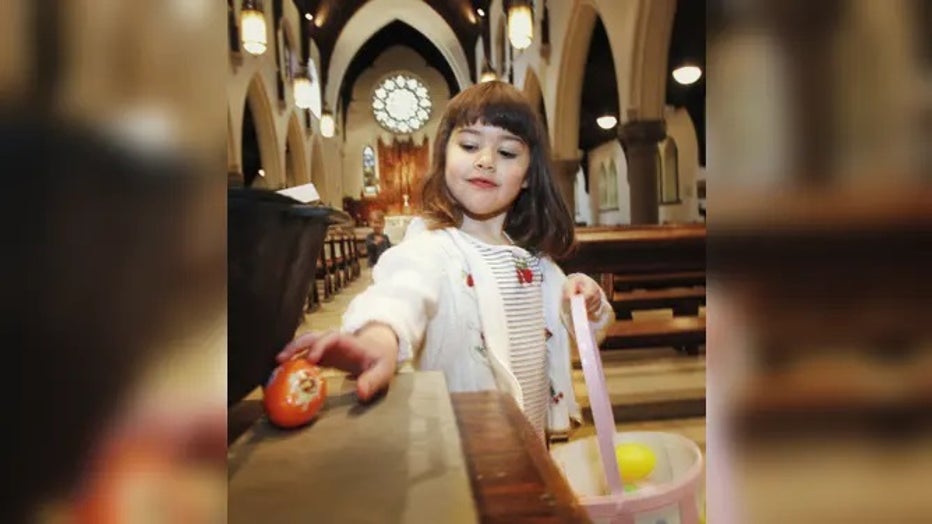
A little girl finds an orange egg during an Easter egg hunt at church. (Derek Davis / Portland Press Herald / Getty Images)
Eggs have played a starring role in Easter due to their ancient association with fertility and new life.
According to Hann, eggs have been associated with Easter from the very early days of Christianity. Christians in the Middle East would dye the hard shell items around the period of Easter and then give them as gifts.
HOW THE YULE LOG EVOLVED FROM AN ANCIENT VIKING RITUAL
"This practice was then adopted by some of the Orthodox churches in Eastern Europe — in Russia, in the Middle East — and then that passed through to Western churches as well," he said.
Within a western church, the practice of hunting for eggs came to be when the first known egg hunt was hosted centuries ago by Protestant reformer Martin Luther.
According to Hann, Luther organized egg hunts for his congregation, in which men were sent to hide eggs and then women and children were sent to find them.
"This was supposed to be a nod to the story of the Resurrection because, obviously, the empty tomb was discovered by women," he said. "[Luther] was trying to draw attention to the role of women, in particular, and children in trying to find what has happened to Jesus after the birth after he risen from the dead."
The origins of the Easter Bunny
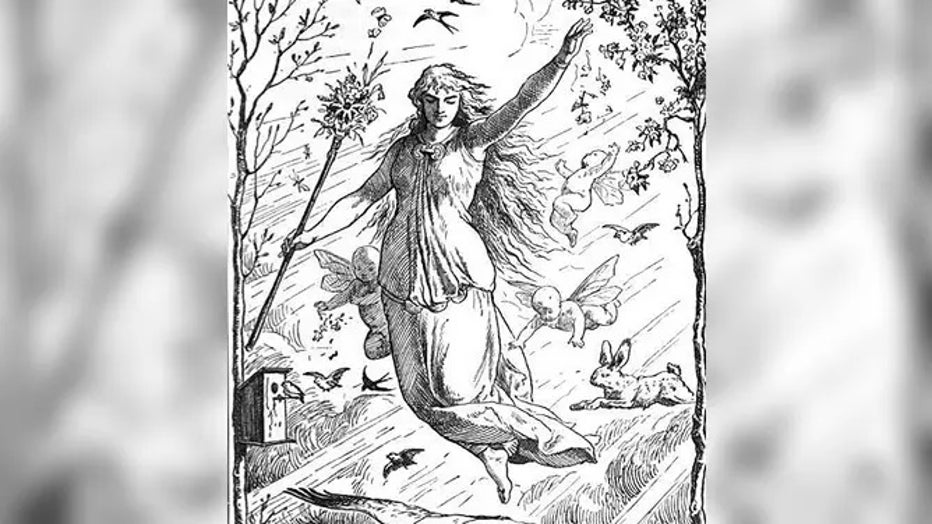
A rabbit chases the heels of the goddess Eostre in this drawing by Johannes Gehrts. (Library of Congress)
Much like Easter eggs, the tradition of the Easter Bunny is centuries-old, and one that is tied to rabbits and hares being ancient symbols of fertility.
Rabbits and hares are associated with fertility particularly in the spring, a time of year when life returns – a return of life that is then linked to the Resurrection.
According to Hann, the earliest known reference to an Easter Bunny was actually an Easter hare. The reference is found in a 1682 book by German Georg Franck von Frankenau, who links hares and rabbits with Christianity.
"He talks about an earlier tradition in Central Europe that this is coming from [the hare’s] association with fertility and the Virgin Mary," Hann said. "Sometimes you see the paintings of the Virgin Mary, and you see a hare at one side of her."
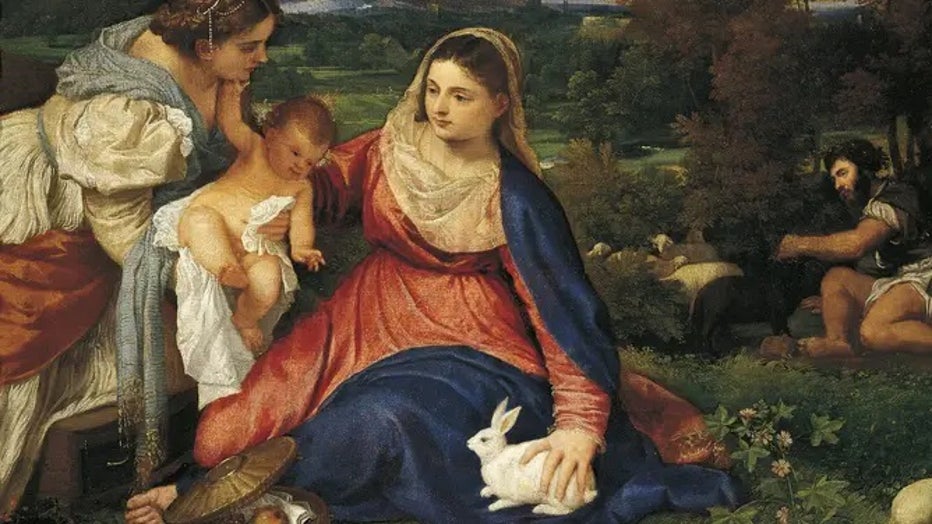
The Virgin Mary is depicted with her left hand on a rabbit in the painting "The Madonna of the Rabbit" ca. 1530. (DeAgostini / Getty Images)
Eventually, the traditions involving Easter hares and eggs came together.
In 17th-century Germany, Hann said a strong tradition at the time involved an Easter hare known as the "Osterhase." The Osterhase delivered eggs to children who exhibited their best behavior.
HOW MARDI GRAS BLOOMED FROM ANCIENT TRADITIONS
This tradition of the Easter hare then began to spread outside of Germany. During the 18th and 19th centuries, German immigrants brought the idea of an Easter hare giving eggs to children to the United States.
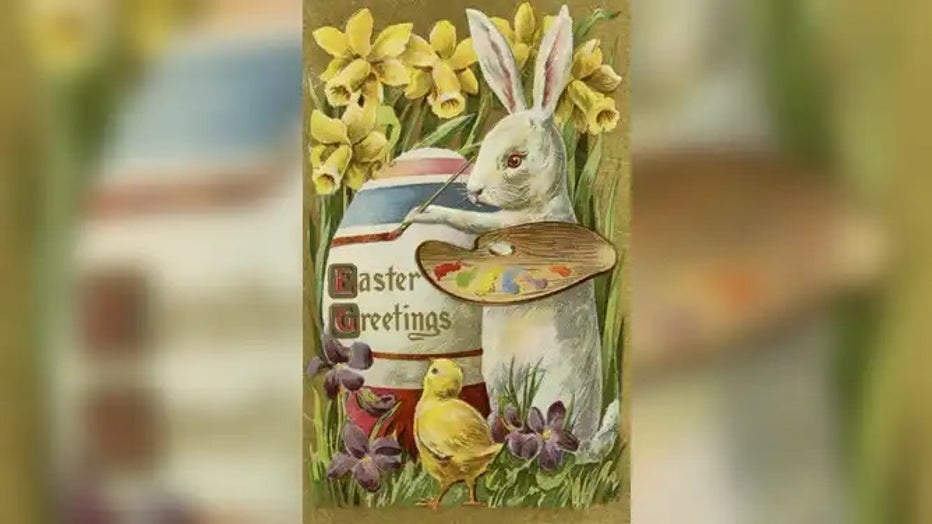
In this Easter postcard, an Easter bunny paints an Easter egg as a baby chick watches below. (Jim Heimann Collection / Getty Images)
In America, however, the Easter hare experienced a bit of a makeover and was replaced by a cuddlier alternative, the bunny.
Compared to hares, bunnies – which are young rabbits – are generally smaller with shorter ears and shorter hind legs.
Then in the 20th century, Hann said the Easter Bunny was imported from America back to Europe.
"So, it’s come full circle," he noted.
A holiday celebrated around the world
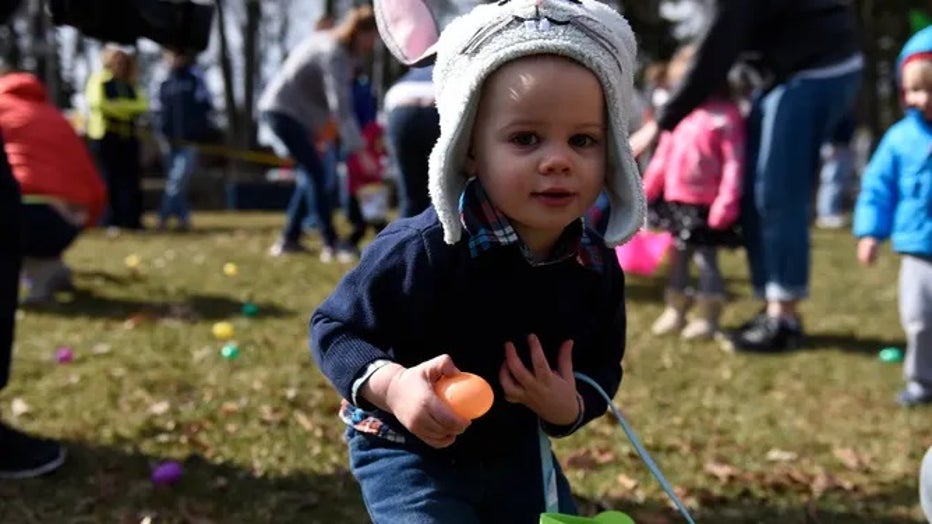
A little boy sports a bunny hat while hunting for Easter eggs. (Jeremy Drey / MediaNews Group / Reading Eagle / Getty Images)
Today, many families celebrate Easter with church services, along with treats, eggs and the Easter bunny.
"Easter has always been this period of this moment of celebration and renewal," Hann said. "And so, it's always been a very joyous time for Christians and a time of quite a lot of merriment."
"It's just a period when it's been really positive – the beginning of spring, the beginning of new life and everything," he added. "It's just a nice time to be alive."

